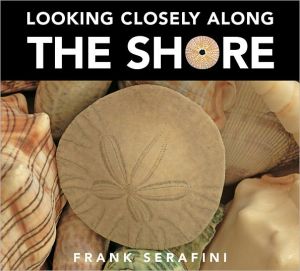

 |

|

The average rating for Looking Closely Along the Shore based on 2 reviews is 4 stars.
Review # 1 was written on 2017-03-16 00:00:00 Eugene R Frazier Eugene R FrazierIn looking closely along the shore, the book talks about things people can come across when they are on the shore, it makes you predict by asking what we see and it gives us a hint by providing a zoomed in picture of what it is, then on the next page it tells us. It includes a sand dollar, a gooseneck barnacle, a lined shore crab, an ochre sea star, a coconut palm tree, a blue mussel, a queen conch shell, a sea anemone and a coastal rock. The book gives a brief description of what these cool things are, along with a great photograph on the page. My impression of the book, is I really enjoyed reading it, it kept me wondering what the next cool image was going to be, it really informed on things I would never think of being on the shore. The images on the book were awesome, because they covered a whole page and more, and gave us up close shots with very good resolution. The style in this book I would say is descriptive because it give us facts and it describes the things very well for example the coconut palm tree in the book it describes and states facts by saying "Palm trees grow in warm or tropical places. They hang over the beach and sway in the ocean breeze" and "Coconut palm trees have the biggest leaves of any plant in the world" and when it describes the sand dollar "When alive, sand dollars are covered with tiny hairs" This is why it is descriptive style because it is informing the reader. The tone of this book I would say is curious and informative, curious because it says "Look very closely, what do you see? A flower? A Fossil? What could it be?" It makes you think about what the close up image could be, makes it curious and makes us the reader predict. Informative because it states facts about the images. In the gooseneck barnacle the book says "Gooseneck barnacles keep their shells closed unless they are eating" This is how the tone of the book is informative in a descriptive way. Some visual elements I saw in the book was the font of some of the words where it says "Look very closely" these words are extra big, bold and black. I believe the author did this to get us wondering and into the book, and to make the book fun by curving some of the words. I also noticed the images that are zoomed in where we guess what it is. It is all in black and a circle of the zoomed in image in the center, I believe he used the color black so we can focus and think about the zoomed image that has colors. The images also bleed through the entire page, which makes the images bigger it gives us a better detailed image like if we are there in the shore. Also in the last pages a big photograph spreads though the entire two pages of the shore, which I believe it looks awesome because that can be where he took the photos, giving us thoughts to go there and look for those things he mentioned on the book. |
Review # 2 was written on 2017-03-18 00:00:00 Salvatore Panebianco Salvatore PanebiancoFrank Serafini creates a portal to the shore through his visually stunning photographs, inviting children (and adults) to explore every detail within them. The book introduces a habitat and then offers cropped images of a photograph containing something native to this area, such as a sand dollar at the shore. The cropped image is accompanied with questions and suggestions on what the item may be and then it is followed by the full picture and a description that gives readers facts about that animal or plant. The photographs make the book, as Frank Serafini traveled all around the world to find the perfect subjects for his habitats. The passion and care he took to take these photos translates beautifully into great nonfiction pieces of literature. The most obvious literary element used is setting. The title states it quite clearly as the shore, but keeps it vague enough to include any shore in any part of the world. The pictures bring those words to life. It brings the readers to the shore and makes them feel as they are wading in the tide pools created during low tide, discovering the sea stars and shore crabs. The way Frank chose to present his non-fiction works speaks to his style choices, as he used the photography medium to display the many things found at the shore, such as the Gooseneck Barnacle. The photographs themselves visually catch the reader's eyes with the natural patterns and colors found at the shore. Serafini uses landscape photography to reveal the shore to his readers. The first page containing the cropped image contains a black page with the circle and inside the circle is the peek at what the reader can find at the shore. The border is big enough to show a good-sized portion of the image without overtly giving away the surprise. The second line of the text on every page is curved, and every time the page asks you to look closely, the word closely is curved as if inviting you in. The stunning visuals presented in the books are timeless representations of these great places ever child should have the opportunity to explore. |
CAN'T FIND WHAT YOU'RE LOOKING FOR? CLICK HERE!!!